Energy in crisis: nuclear goes up the agenda
This week, AI-based facial recognition systems go live on the front in Ukraine, ozone exposure links to teenage depression, and evidence that sleeping with the light on can adversely affect your health. Plus, as the world grapples with an energy crisis, nuclear power is going up the energy agenda. We hear about Rolls-Royce's plans for a fleet of "off the peg" small modular nuclear reactors, and the efforts to harness nuclear fusion at JET...
In this episode
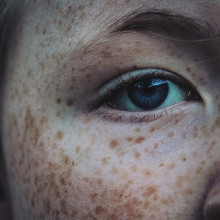
01:05 - Ukraine using Clearview Facial Recognition AI
Ukraine using Clearview Facial Recognition AI
Michael Wooldridge, University of Oxford & Ryan Mac, The New York Times
Last month, we delved into the murky waters of facial recognition technology, asking how comfortable we feel trading our anonymity for our alleged safety. Little did we know then how quickly that question would become as pertinent as it is now for the people of Ukraine. Reuters reported last week that American company Clearview AI, which describes itself as the world’s largest facial network, came to them with the news that it was offering its service free of charge to the Ukrainian government. In what capacity they intend to use the technology is, so far, not entirely clear, but Ukrainian government officials have hinted at using it to identify people of interest at military checkpoints and deceased combatants. Clearview, however, is not without its critics. The response to this development has centred as much on the company’s furthering of its own self-interest as it has on the potentially game changing tool now in the hands of the Ukrainian resistance. James Tytko has this report...
James - Clearview AI CEO, Hoan Ton-That, claims that his database contains over 10 billion images of faces and its AI is even better at identifying people than you or I. I spoke with Michael Wooldridge, professor of computer science at the University of Oxford, to understand how this technology works.
Michael - The classic way that people focused on in the early days of trying to get software that could do facial recognition is to try to reduce your face to some kind of series of signature markers. For example, you would measure the distance between your eyes and the triangle that the center of your eyes make with the tip of your nose, and so on. The idea is if you could find the right set of signature markers, then we get a unique signature of your face, and so when we see a picture of your face, assuming we've seen it before, then we'll be able to recognize it. But the second approach is just to use neural networks, which is one of the contemporary AI technologies of the day. What neural networks are very good at is recognizing patterns, recognizing images so you can in neural networks directly to that and that technique is very, very popular and very successful these days. But to make it work, the software has to have seen your picture before. In the case of neural networks, it typically has to have seen lots of examples in order to be able to recognise you in the future. But now of course, we spend our lives providing social media with pictures of us, very carefully labelled with my name and the name of my children and my wife's name and my friend's name and so on. What we are doing is feeding social media algorithms, and potentially other people that we're not quite as comfortable having access to these pictures, with this training data to recognize our faces.
James - Anyone who's used this facial recognition technology to unlock their phone, for example knows it doesn't work every time, right? How accurate is this technology? It can't be immune to making mistakes.
Michael - By no means is it immune to making mistakes. I think it's probably fair to say that current facial recognition technology in tests is basically better on average than people can. Once you've reached that point, I think you've reached a tipping point in terms of the quality of the technology. But as you say, it makes mistakes, and it makes mistakes like all AI technologies in very unpredictable and weird ways. This is one of reasons why incautious use of this technology is something that we should all be concerned about.
James - In light of my discussion with Michael and his warning to air on the side of caution in the use of AI facial recognition, I was keen to learn more about what kind of company Clearview was specifically. Ryan Mac is a tech reporter at the New York Times, who's been following them for a while.
Ryan - The company claims, and I should stress that they're claiming here, that they have about more than 10 billion photos in their database now.
James - And why do you say that? Why do you say it's a claim rather than taking it at face value?
Ryan - I'd say that because in the course of my reporting, myself and others have found plenty of statements made by the company and its CEO, Hoan Ton-That, that don't end up panning out or are in some ways exaggerated. Perhaps the easiest one to point to is in their marketing materials to police early on in their company history, they were claiming that they had 100% accuracy in their facial recognition technology. If you speak to any expert in the field, no one would ever guarantee 100% accuracy. It's just a bad precedent and standard to set yourself to. There's plenty of other things that the company has claimed that haven't panned out. In any case, they're claiming they have 10 billion photos in their database. They've also claimed in this, that they have 2 billion off of 'vkontakte', which is Facebook for Russia, the most popular social network in Russia,
James - Ukrainian vice prime minister Fedorov Mykhailo has spoken about the scenarios in which Clearview might be used, including identifying deceased Russian soldiers and prisoners of war and looking for missing persons. I wondered what might be in it for Clearview.
Ryan - If you look at the history of this company and some of our reporting, their MO is to get this technology out into as many hands as possible. Through these free trials, hopefully they prove themselves, and then get these police departments or government organisations hooked into paying subscription fees every month or year. But also it's a positive story for them, that their tool is being used in a war. You can see how the company would use that and take that as a positive PR hit for them. They're already using it in litigation. They're being sued in the US for violating certain privacy laws. They've already inserted that into their case saying, 'Hey, actually, we're helping in Ukraine. We are doing good here.'
James - Aside from Clearview's less than squeaky clean record, the use of AI facial recognition in wartime is a big point of concern.
Michael - If this software was used on checkpoints by people, guns to try to identify their origin and so on, that isn't a way that I would like this technology to be used. Of course, all of us desperately feel for everybody in Ukraine, but this doesn't feel like a direction that we should be going or a responsible military should be going.
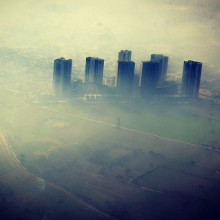
07:23 - Teenage depression linked to airborne ozone
Teenage depression linked to airborne ozone
Erika Manczak, University of Denver
The harmful effects of air pollution have been reported many times, and the stats speak for themselves: according to the World Health Organisation, breathing bad air kills 7 million people per year. But apart from its impact on physical health, something that's not been looked at in detail is how pollution may also affect mental health, especially in younger people who may be more vulnerable to its effects. This is a shortcoming that Erika Manczak from the University of Denver set out to explore. She explained to Chris Smith how she found a strong link between teenage exposure to ozone, which is one constituent of air pollution, and the development of depression…
Erika - The California environmental protection agency regularly collects information from air quality monitors on things like ozone. I was able to take that data and essentially map it onto a study we were conducting that was looking at adolescence in San Francisco over a four year period.
Chris - And the two overlap. You can then say 'Here's what the air is doing and here's what their mental health is doing.'
Erika - Exactly. Yes. We were able to take our participants' home addresses and identify which census tract they lived in and then take the state of California data and identify what are the average, ambient ozone levels for that census tract.
Chris - What relationship emerged when you did this?
Erika - We began following our adolescents right before the onset of puberty. When most of our participants were somewhere between 9 and 13 years old, we then followed those same teenagers over the next approximately 4 years, while each of them transitioned through puberty. One of the things that we found was that there actually was not an association between mental health symptoms and ozone at baseline when the adolescents were pre-pubertal. However, once they transitioned into puberty, we began seeing significant differences in mental health according to ozone level. Adolescents who are living in a census tract that had relatively higher levels of community ozone showed significant increases in depression over that 4 year period. Whereas adolescents who are living in communities that had relatively lower ozone exposure, actually didn't show any significant changes in their depressive symptoms.
Chris - Can you disentangle the effect of the environment? Because if I live in a really downhill place where my exposure to environmental pollution is likely to be high, equally my exposure to a raft of other factors; Crime, poor environment, poor outdoor space availability, and so on. Those could well be playing a role. Can you get apart those two different aspects to this?
Erika - Excellent question and something we were really concerned about trying to untangle, since this is essentially a correlational study. We can't firmly clarify whether our associations are causal, we can only look at whether these things go together. Within this study, we were able to also look at things like the number of families living below the poverty line, socioeconomic status of individual households, as well as things like how many people in a community had finished a high school education. We're able to show that our effects were not accounted for, by some of these other community level concerns.
Chris - This would argue then that there is genuinely something about exposure to this pollution, and whether it's the ozone or something else that's there, that you are not measuring, but it's there at the same time as ozone, either could be possible. But how do you think this might be happening then? What's the mechanism?
Erika - One of the things that we know from the research on physical health effects of ozone is that inhaling ozone can increase inflammation in our lungs, but also systemic inflammation throughout our body. In-turn, we know that systemic inflammation is associated with things such as asthma or cardiovascular disease. However, in psychology, we're also recognising that those same patterns of systemic inflammation are also linked to depression and depressive symptoms. Perhaps one of the biological pathways for our findings would be that inhaling ozone might increase inflammation in the body, which would then put adolescents at greater risk for depressive symptoms as they aged.
Chris - What's puberty got to do with it? You mentioned that there was not a difference at baseline. In other words, before they went into puberty, everyone sort of faring the same. Are you just more vulnerable when you go into puberty?
Erika - Yes. That seems to be the case at least for depressive symptoms. Thankfully levels of depressive symptoms in children prior to puberty are relatively low. However, once kids begin puberty, we do see a pretty significant increase in depressive symptoms, suggesting ultimately that there seems to be heightened risk during that pubertal change. Precise reasons for this heightened risk are a little bit unclear. It certainly might have something to do with hormones and also might have to do with really dramatically changing social environments. Within our study, our findings parallel this pattern pretty nicely, suggesting that prior to puberty we don't really see these risk associations, but once puberty occurs, we do begin to see some of these emerging.

11:51 - Material that hears like your ears
Material that hears like your ears
Yoel Fink, MIT
Sounds are airborne pressure waves that our ears are well adapted to picking up. But what if your clothes could tune into these tiny waves too? Evelyna Wang spoke with MIT's Yoel Fink who's making fabrics that can listen in like our ears do...
Yoel - In a way fabrics contain the soundtrack of our lives. They are present from very soon after we were born to our last days. However, until now, that soundtrack was not accessible to us. What we set out to do is see if we could create an ear in a fabric.
Evelyna - How did you design a fabric that could pick up on the soundtrack?
Yoel - One thing was that when a sound wave hits a plane or hits a fabric, very small waves are created which aren't that different from the waves that are in water. I'm really referring to those waves that are created in fabrics when we talk to each other. Right now, when you're listening to this podcast, they're very small waves that are generated in the fabrics you're wearing. Now that gets me to another angle, which is the ear. Fibres are an important part of the detection of sound in our ears; both at the front end of hearing, conversion of pressure to vibrations, and also on the back end of hearing, converting those waves into electrical signals. Our work and research focuses on fibres and we then said, 'Wow. Could we take those learnings from the ear and realise that same type of hearing functionality, not now in a 3 dimensional, complex and delicate organ, but actually in a 2 dimensional, flat, flexible and durable, and maybe even machine washable fabric?'
Evelyna - Yeah. This fibre that you designed, can you tell me a little bit of detail about what went into it?
Yoel - In order to detect those waves, we needed to construct a fibre that conformed to those waves, that moved with them; Think about a piece of seaweed in the ocean. We needed a fibre that bent with these very slight waves. We also wanted a fibre that not only moved with the waves, but also reported on them and sent us an electrical signal, and that defined the materials we use to make our fibres. There are two important materials. One is very highly flexible, actually most of the fibre is made out of a rubbery type of material, internal to the fibre is a thin layer of a material that we refer to as a piezoelectric. When that material is bent, it generates an electric signal.
Evelyna - Right. So you have this fibre embedded in your fabric bending and causing electrical signals. How then did you gather that and turn it into a sound?
Yoel - In the end you still need to capture that signal and there are small little micro wires that are running through the fibre that conduct that signal to the edge of the fibre, where it could be picked up. Those are just signals. Turning them into information and useful information requires additional steps.
Evelyna - Right. So how far did you guys get on the processing end of the signal?
Yoel - Our general approach to fabric is framed by a vision that 'fabrics are gonna be the next form of computation'. What we're saying is that the cell phone in your pocket is not gonna look like the object in your pocket for much longer. It's gonna look like fabric. We think about that vision in terms of 4 elements. One is making fibres that have some very special properties and functionality like a microphone, but not only microphone we've made fibre batteries. We've made digital fibres, that store information that could run programs and so on. The second step in that vision is to combine those fibres into a fabric, which becomes a computer. We haven't gotten there, but we're getting closer. Step number three is to implement certain programs to understand the context of those signals. Finally, level four of this vision is to provide services through apps. For example, if you have a hearing aid and you want your fabric to help you to function in a noisy environment. You're gonna have an app for that. And if you're a pregnant woman and you wanna listen to the foetal heartbeat, you're gonna have an app for that. We envision a world where the fabrics are gonna be capable of doing lots of different things for us.

17:12 - Diabetes linked to sleeping with lights on
Diabetes linked to sleeping with lights on
Phyllis Zee, Northwestern University
Are you a lights off, or a lights on person? I’m talking, of course, about when you go to sleep. Some people like to keep a light on overnight, but now new research suggests it’s a bad idea and, instead, sleeping in the pitch black is better for your physical health. Naked Scientist Harry Lewis is a big fan of sleeping in total darkness...
Harry - I certainly do Chris. Ear buds out. Blackout curtains open. Ready for the day. That's right. New research coordinated by Phyllis Zee, chief of sleep medicine and department of neurology at Northwestern University, illuminates the health risk of sleeping with the light's on. I caught up with her, but when I did, she wasn't actually in Illinois.
Phyllis - I am in Rome right now. In Italy. In the eternal city.
Harry - It was the last place I went before the lockdown started to get put in place. It's quite a bright city. Although you are covered with the historic relics, there's a lot of light around.
Phyllis - There is a lot of light around in the center of Rome. I noticed that many of the ruins and beautiful historic sites are also lit at night. But the street lamps can be quite bright if they're right next to your window, especially when you're trying to sleep.
Harry - And that's what we're coming onto. A bit of research that you've probably recently, discussing the effects on our health if, when you are sleeping, you are in the presence of lighting. What are your findings from this research?
Phyllis - What we found was even in very healthy, relatively young people, having them sleep with their lights on compared to if they were able to sleep in much, much dimmer light, which was like less than three lux, that there was a difference. Those who slept in the room light had a higher heart rate throughout the entire sleep period, and the next morning, we challenged them with glucose. They drank a bunch of glucose and we found that the group that slept in the light condition had what we call 'insulin resistance'. That means that to keep their blood levels of sugar and glucose normal, the body had to secrete more insulin. That is what we see in, for example, people with type two diabetes. The tissue is less sensitive to the hormone insulin.
Harry - If we extrapolate this out, does that mean that if you were to sleep in the presence of light, not too much, but just a little bit, then this could result in somebody being more likely to be diagnosed with diabetes?
Phyllis - We know that having insulin resistance and increased heart rate during sleep, normally your heart rate should be going down during sleep, could be a risk factor for the development of what we call cardiovascular or metabolic disorders. There are other studies and one that was published just last year. What they found was that those who were sleeping with lights on during the night, whether it was from a lamp, a television, or outside light, were at higher risk for obesity.
Harry - I feel like because we've grown into this era of light being all around us. There must be a lot of research into the effects of light on our health when we are sleeping. Is that the case? Am I right in that assumption?
Phyllis - There's actually not as much research of light while we're sleeping. Most of our research has focused on light in the evening, usually before we go to bed. When you're awake, you're in bed and you're looking at your phone, you're looking at your light emitting devices. It's really more in that pre-sleep period. I actually was surprised. I don't sleep with the lights on, but there was a survey done in Britain that somewhere about like 30-40% people sleep with their lights on. I mean, that's a lot.
Harry - Yeah. I mean, I've got a little radio next to my bed and it actually pumps out probably enough light for me to just about see around. Maybe I should be turning that off before I go to bed.
Phyllis - Yeah. Especially the blue lights, your brain is gonna be much more activated by short wavelength or blue to green types of light than it would be for red or amber colours. I say sometimes people have to have their lights on for safety reasons, but think about changing that colour. Certainly if it's blue to something that's a little more on the red side. It can affect sleep. It can affect what you eat. It's really another modifiable factor that we can use to improve our health.

22:21 - In health terms, what constitutes well-lit?
In health terms, what constitutes well-lit?
Tim Brown, University of Manchester
We've discussed the importance of darkness during sleep, but what about getting the light right too? That’s the thrust of a paper in PLOS Biology this week, which attempts to provide some expert guidance on appropriate light levels. Tim Brown is one of the authors...
Tim - Of course we do have regulations for how much light we should have in our buildings. These are all focused on providing enough light for us to be able to see, read, navigate safely, etc, but they don't take into account effects of light on our body function. Regulating our body clock, which is a really important determinant of our health and wellbeing and effects on our alertness. And actually the systems that regulate them in our body are quite different from the rod and cone cells in the eye that we rely on for vision. It's a completely different system and it needs a new way of measuring light.
Chris - So in essence, then we understood the science because research is like yourselves have been talking about the importance of light exposure to feeling good mood waking up in the morning, setting your body clock, getting over jet lag, et cetera. They've been talking about that for decades, but are you saying that it just hasn't made its way into the sort of workplace psyche, domestic psyche in a way that really needs formalizing and people need clear unequivocal guidance.
Tim - You are quite right that we've recognized this idea that we probably need to get more light during the daytime and less light in the evening for a long time. But the question has been, how do you put a number on that? And actually it's not just a question of agreeing for numbers, but really it was agreeing the proper way of measuring light, because as I said, it's a different system. As you can imagine, when you experience light, what you are seeing is a range of different wavelengths and those different wavelengths of light don't equally affect these systems. The importance of blue light is because actually the biological system that regulates these things has a light sensitive protein that's particularly sensitive in that short wavelength, blue part of the spectrum. There's been disagreements about exactly how we should measure that. One of the things that came out of our report, which is a consensus agreement across many experts working in this field from across the world, was a new way of measuring light, which is relevant to this system. We were able to formulate our recommendations in this new, more appropriate light measurement approach
Chris - Is one frustration that lighting technology has completely changed out of all recognition in the last two decades where you said light bulb to someone in the year 2000, that means something completely different in the year 20 you two where most lighting is now LED. We went through a phase of having compact fluorescence and people said they were disturbing their sleep. Are you able to make your regulations or your guidance kind of future proof in that respect?
Tim - Yes, because they're not tied to any particular lighting technology. Although what I would say is actually, although people have been worried about the idea that there's a big blue component in LEDs, you have so much more control over LEDs to the extent where you can now tune the different wavelength bands within it to produce a light of a particular property. And the upshot is that we can start thinking about having two different lights. They might visually appear identical. One would have a stronger effect on our body clock than the other, just by tuning the mixture of wavelengths that are present
Chris - Is the elephant in the room, though, you might go to enormous lengths to advise on how to build better offices, better homes, better bedrooms that illuminate people in a way that's gonna be more in sync with their physiology, the way their body's trying to work. But if they're sitting there deluging themselves in bright light from a screen, then they completely undo all the good work you're doing.
Tim - One thing I imagine is that actually, we now know that increasing the amount of light we see in the daytime has some kind of a protective effect against the disruptive effects of light later on. In that sense, making things better during the day helps. But I suspect that increasingly we'll see personal light monitoring devices, similar to the kind of things that many of us wear on our wrists. Now that tracks other aspects of our health.

27:34 - Energy crises and the case for new nuclear
Energy crises and the case for new nuclear
Simon Taylor, Cambridge University & Jeremy Gordon, "fluent in energy"
Driven by supply shortages - and pursuit of a green agenda across multiple geographies - many countries were already facing an energy crisis. Fuel prices at the pumps are at eye-watering levels we’ve never seen before, and some people have seen their power bills double in a matter of months. One consequence of the energy deficit is renewed interest in nuclear power, which under the circumstances is looking very attractive as an option, as energy consultant Jeremy Gordon, who runs the nuclear advocacy initiative “fluent in energy”, and Simon Taylor from Cambridge University's Judge Buisness School, explains to Evelyna Wang...
Simon - The UK was one of the pioneers in nuclear power and nuclear power has made quite a significant contribution to UK electricity generation over many decades. It's still around 15% of the power that we produce, but it's now shrinking, or about to shrink, quite rapidly because, on current plans, all but one of the older stations will close by the end of this decade. So, unless we build new nuclear stations, the nuclear share will shrink. The problem has been that new nuclear has proved economically very troublesome, both in the United States and in continental Europe.
Evelyna - Why is it so challenging to get a new station built?
Simon - Nuclear power plants are exceptionally complex structures. The underlying argument for nuclear is that you get a great deal of energy from a very small quantity of uranium. The problem is that process generates a great deal of radiation, which is dangerous, so you have to build protective structures around it. You also have to build in various backup systems to make sure that in the event of an accident or a loss of power, the plant can shut down safely. That essentially makes for a very complex structure which, in turn, Is very complicated to build. The good news is that there is learning by doing in nuclear, at least to some extent - there is a sense of benefit in building more of these stations because you get better and better at doing it, and the costs will progressively come down. How much lower remains to be seen. There is some evidence that things are getting better, but investors are obviously sceptical about this until it's actually happened, and that's where the government has to take some of the risk.
Evelyna - I see. If they were to build new plants, then where would these be located?
Simon - Well, the government did a sighting survey quite some time ago and identified several sites, which are almost all existing sites, where there are nuclear power stations of the first or second generation, some of which have now closed. These are all sites that have both the physical characteristics which, amongst other things, is that they need to be reasonably far from urban areas and they need to be on the coast because you need a lot of water for cooling and the grid connection is already there, which means you don't have to add a great deal of extra investment. They also have, for the most part, local support because nuclear power stations employ quite a lot of people; they generate very well paid jobs, additional economic activity in what are typically rural areas where there isn't a lot of alternative employment.
Evelyna - As a projection into the future, do you think we can count on nuclear technology as part of a clean energy future?
Simon - The main case for nuclear is that it is a proven source of reliable and predictable low or zero carbon electricity. The value of having predictable and reliable electricity supply, particularly in the winter, is quite high. So, I think there's a pretty good case for the UK to have at least some nuclear as part of the mix, as long as it's not outrageously expensive. As I say, the evidence is that it's getting better. With what's been going on recently in Ukraine, one message that's come through is that being dependent on imported energy is a risk. I would expect this to reinforce the case for nuclear in the UK and possibly other countries as well.

33:53 - Small Modular Reactors: a new nuclear concept
Small Modular Reactors: a new nuclear concept
Mark Salisbury, Rolls Royce SMR
The costs of constructing new nuclear plants run into the billions. This is partly because they’re bespoke builds and few in number, which limits the opportunity to benefit from economies of scale. And that’s where the Rolls-Royce company Rolls-Royce SMR comes in. SMR stands for Small Modular Reactors. Their vision is for a fleet of nuclear reactors but on a smaller scale and made on a production line, keeping costs down. Within the last week or two, they’ve just submitted their proposal to the industry regulator for appraisal. Mark Salisbury, heads the company’s regulatory assessment team and talks to Chris about the plan...
Mark - I think our customers might feel a little hard done-by if we gave them the instructions and asked them to assemble it themselves. But in essence, that's what we are looking to do, maintain high quality products that we can roll out at a fast paced to help the country meet net zero, but still maintaining safety as our utmost priority.
Chris - When we say these are small reactors, how small is small? What could you power with one of these?
Mark - Physically in size for one of our SMRs, the site would be about the size of two football pitches, and that would provide enough electricity for about a million people over its 60 year lifetime.
Chris - And if one compares two football pitches for one of your units compared with say one of the current nuclear stations we have in the country at the moment, how do they compare size wise?
Mark - Again, on the physical size, it is roughly about five times the size, but the electrical output is much higher, able to power about three to 4 million homes. It's not so much that one is better than the other. We're going to need a mixture of everything to help us meet our net zero goals, but it's finding the right technology for the right situation and using them all together to achieve net zero.
Chris - Where will you put them?
Mark - We are looking at a number of sites, the first ones that are readily deployable will be on sites or next to sites with an existing nuclear power station. For the same reason that Simon mentioned about where we site nuclear power plants, places where people are used to them, we have the grid infrastructure ready, and they have the geology, geography and makeup that we are looking for. As we move out and hopefully expand the fleets of plants that we are looking to construct and that others are looking to construct we'll need to look at other sites. We'll be looking for sites that are close to areas of high energy demand, but have similar characteristics to sites that we see at the moment that have existing nuclear plants on them.
Chris - And are these pretty much the same technology we already have, or are these a brand new way of harnessing nuclear energy?
Mark - They're a bit of both really. The technology that they're based on is called a pressurized water reactor, and those have been in operation globally since 1957. It's a very well understood, very well refined, very mature technology that's been improved and optimized over the decades. The way that we are different is that we are shrinking that down and we are creating a product line. We will have factories that we'll be able to ship parts to sites and then install within a factory on the site itself. That will drastically speed up construction time and reduce costs.
Chris - Basically you've got a slew of factories around the place that are making the parts, where will those parts be sourced? And is this something that you can set up to make it sustainable? Will it be locally produced or are we gonna be buying bits from other countries?
Mark - That's a really good question. Some of the parts we will have to import, but what we are looking to do at Rolls Royce is also by shrinking the size of the technology, we're able to increase the market size for the supply chain in the UK. We're looking to build factories in the UK to build these plants. We're looking to create a fleet of reactors and create about 40,000 jobs by 2050. And we estimate that will generate about 52 billion pounds in economic benefit. We are very much looking to grow both our nuclear generating capacity in the UK, but also our manufacturing capability because otherwise we could end up trading one problem for another
Chris - People are still wary about nuclear, how safe are these and what safeguards are being put in place to make sure that people can sleep easy?
Mark - Nuclear plants are incredibly safe from a security and a safety perspective. We use a multilayered system of defenses or multiple barriers to help safety, and each of those has a redundant or a diverse means of achieving the same aim. If we need power to a site we might have offsite power. We might have diesel generators. We might have batteries and the same with our design of power stations. Nuclear plants rely on what's called passive safety. That's not necessarily requiring power or a pump to run to keep something cool. That's relying on natural forces like convection or gravity to keep a plant safe.
Chris - The other thing which does concern people very much is what we do with the waste.
Mark - Sure. It's a good question. I think it's important to put it in perspective that every process on earth creates waste and nuclear is no different. From over 80 years of nuclear science and technology and medicine research, industrial purposes, energy generation, and defense, we have generated nuclear waste in the UK and we will have to deal with it. The other thing to bear in mind is the size or the magnitude of that waste. High level waste, which accounts for about 95% of the radioactivity, the stock part, if we put that all together in the UK would cover an area only a quarter of the size of a football pitch. If we look to deploy a large fleet program in the UK for about 16 gigawatts, we'd only be adding about 10% to this existing stock pile. Now we know what to do with it. Nuclear waste is normally in the form of concrete or ceramic or metallic material and we box that up and confine it and store it. Unlike chemical waste or other types of waste, radioactive waste does decay in toxicity over time. We know what to do with it. Currently, it's stored at specific locations and the government is looking to build a facility to take these wastes and be able to store them whilst their radioactivity decays over time.
Chris - And if the regulators who are currently considering your proposals do give it the nod. What's the timeline for implementing this now?
Mark - We're looking around 2030 to be able to start rolling out our small module, the reactors, and once we get the factories up and running, we'll be able to roll them out in quick succession.
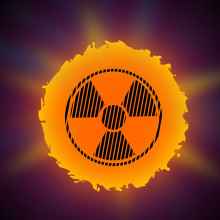
41:48 - Joint European Torus: towards nuclear fusion
Joint European Torus: towards nuclear fusion
Fernanda Rimney, JET
We’ve heard of nuclear fission - splitting the atom in common parlance - but there is another form of nuclear power, one that boasts the potential of being almost limitless and is said to be safer and cleaner. That’s nuclear fusion. Rather that breaking atoms apart, fusion involves pushing smaller atoms together to make bigger ones. It’s the process that powers the Sun, so we know it works. The challenge is trying to recreate the conditions inside a star, that make fusion possible, here on Earth! One of the places where they’re trying to do this, with some success now, is JET - the Joint European Torus, at Culham. Evelyna Wang went to take a look around...
Fernanda - Fusion happens when two light elements fuse and release more energy than what they had before.
Evelyna - That was Fernanda Rimney, a plasma physicist and JET's senior exploitation manager. JET stands for Joint European Torus. The shape of the reactor is included in the name. JET is a torus, or a donut. This shape is essential for the research.
Fernanda - The way we confine this very hot plasma, the very hot fuel that we need to produce fusion, is by using magnetic fields. The plasma is made of ironized particles. They stick to the magnetic field.
Evelyna - The fuel, or plasma, needs to be extremely hot, over a hundred million degrees Celsius, if the atoms are to gain enough energy to fuse. However, it isn't so simple. As the plasma heats up, it wants to expand outwards - it wants to collide with other matter which, in turn, cools it back down. The solution is to trap it with big magnets, forcing it to spiral around the reactor. The researchers here at JET have had success. At the end of last year, the team set a new record for longest fusion ever recorded: five seconds. I was keen to get a closer look at JET, but the first stop on my tour was the control room.
Fernanda - The glow that you can see on the screens, there, that's plasma. We have cameras looking inside the vessel. The simple view that you get here is just to check that everything is alright.
Evelyna - Am I allowed to ask what experiments they're running now?
Fernanda - Now they're running the clean up experiments; so, fairly low power, very low temperature experiments. From tomorrow, we go back to running some of the higher temperature experiments. We will put in some additional heating in the plasma, and then we go on with those until the end of the week.
Evelyna - We still need to work out the optimal conditions for experimenting with plasma. As funny as it sounds, that was JET's original purpose. It was built to study plasma. These experiments will better inform the nuclear fusion reactors of the future to allow us, one day, hopefully, to smash the current record.
Fernanda - Most of the experiments are a scan of something. You have your basic plasma and then you slightly change the heating power, the density of the plasma slightly, the magnetic fields. You try to change one parameter at a time.
Evelyna - Everyone looks so busy!
Evelyna - From the control room, it was a quick walk to the next building where the fusion reactor actually was.
Fernanda - It's going to be very noisy.
Evelyna - Okay. Wow.
Fernanda - Behind those yellow doors (is where that's coming from). Because the machine is operating, these doors are closed and there is another shield, a secondary shield.
Evelyna - The assembly room was a huge warehouse bustling with people moving around large boxes. There was even a giant crane plonked in the centre. Because JET is constantly in use, I wasn't able to get my hands on the actual reactor, but I did get to see the next best thing.
Fernanda - You can see the mock-up, up there.
Evelyna - That's the replica?
Fernanda - It's not just a replica. JET is built in sections like an orange - it's built out of eight octants. When they built it, they built nine. They built an extra one as a test. It was, full size, and it's that one.
Evelyna - From where I was standing, the replica looked like a metal donut propped up by big metal scaffolding. Compared to the real reactor, the mock-up was missing all of the external wiring, thick tubing for cooling water, and giant magnets. But still, I went up the stairs and pressed my face against the window.
Fernanda - This is the size of JET.
Evelyna - It's about the size of four shipping containers arranged in a cube. On the inside, it was a big hollow donut. Metal plates lined the walls like scales. Curiously, inside the mock-up, there was a large boxy looking robot. Fernanda told me that maintenance inside the reactor is carried out by the remote handled robot named Mascot. The replica of the reactor is used to train operators in manoeuvring that robot. To get a sense of what she meant, we went into the remote handling room.
Fernanda - This is the remote handling control room.
Evelyna - This is so cool!
Fernanda - Yeah, this is one of the coolest things ever.
Evelyna - Inside, there are two handles in the middle of the room, and on the walls were several big TV screens.
Fernanda - Basically, there would be one person controlling it from here.
Evelyna - So, they just stand right there and use the handles?
Fernanda - They use the handle, and the manipulator, and the mascot gets into the torus, and does whatever is needed from taking tiles of unscrewing things and then putting things on again. The mascot has got cameras, so there is a full view of what the person is doing. It is not an accident that the people who designed JET were all people with dual physics and engineering backgrounds. It was really at the core of the design and of the exploitation ever since.
Evelyna - The lessons and experiments done at JET inform the design of ITER or International Thermonuclear Experimental Reactor, a new fusion reactor being built in France that is twice as big.

48:44 - Role of robotics in nuclear fusion
Role of robotics in nuclear fusion
Rob Buckingham, JET
Inevitably, robotics will play a massive part in that plant too, which is why this technology is a major priority at JET and the whole project is designed around them, as research facility director Rob Buckingham explains to Evelyna Wang…
Rob - We are not gonna be able to get people inside a fusion power plant. Certainly inside the vessel, almost certainly outside the vessel, and maybe for quite a lot of the plant. We can't put people in, work still needs to happen. We still need to intervene. We need to inspect, upgrade and we'll need to maintain. That's where robotics comes in. A fusion power plant is not a simple thing, therefore the requirements on robotics are beyond what we can do at the moment.
Evelyna - How much does the design of your robotics influence then the design of a plant?
Rob - A lot. It's a big challenge because we've got to think about this whole thing in a different way. We are definitely part of the conversation around the table with the people who are designing the plasma and the people who are designing the heating and drive systems to come up with the best possible design.
Evelyna - So the kind of testing you would do here factors into the build of if you had to implement this.
Rob - Yeah. Behind you is Mascot. This is Mascot-6. The ones you saw over in JET were 4.5. Don't ask me where 5 went, we don't know, we lost it. This is Mascot-6 and we've moved to a fully digital control system.
Evelyna - I see there's little rubber ducks. Are those used for testing?
Rob - Yeah, they are. Yeah. This seems to be our standard test kit, so they're slightly squidgy and we use them for picking things up and putting things down. One of the important things about Mascot is that the operator feels the force being put on the remote arms. If you think about how much a person uses force to do tasks, especially with they're handling and manipulating, you're not really using your eyes anywhere near as much as the sensation in your fingers. Getting that sensation into the operator's fingers is really important.
Evelyna - Are there other applications that you would want to be able to translate the kind of research?
Rob - We are trying to collaborate with as many sectors as possible. The sectors which are most closely aligned to fusion the first one is 'Fission Decommissioning'. Taking apart fission reactors and other systems that were built over the course of the 20th century. Then robotics goes into health, defence, farming, renewables, maintenance. It'll be interesting to see what happens with wind farms as they go further and further out into the oceans. They'll have to be remotely maintained, so they'll have to be designed to be remotely maintained. There are big conversations that are ongoing on that sort of front too.
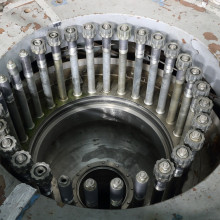
52:13 - New materials to make fusion feasible
New materials to make fusion feasible
Andy London, JET
New technologies also often require new materials to cope with the demands engineers are placing upon them. It’s a bit like the new generations of steels and casting methods that accompanied the invention of the steam engine. And in the case of nuclear fusion, the extreme operating conditions, and the high energy of the plasma at the heart of the process, means our present generation of materials can’t cut it, and we need to discover where they are vulnerable and how to make better ones, as Dr Andy London explains to Evelyna Wang…
Andy - There have been some really interesting results from JET. We're really interested there in the impact of the plasma on the wall, and that causes a number of different processes. It can cause erosion where you are removing the material, but the material which can be removed is also deposited. Sometimes that's in a very similar area; You have this erosion deposition process dynamically happening all the time. In other places there's parts of the reactor where you have lots of erosion and places where you have a lot of deposition. If we take a cross section through the material, you can see different layers and those almost correspond to different experiments in jets. Different pulses and different conditions that were run is almost like sectioning through a tree and looking at tree rings; You can see different levels of deposition that happened with certain run parameters. There we're really trying to understand what's the influence of how we're running the reactor on the materials surface's performance. We're looking there at the chemical structure, we're looking at the mechanical property change, because that tells us about how the components will perform, and ultimately feeding into the design of new materials that will be more resilient and help the reactor to run better and for longer.
Evelyna - What's an example of a new material if I'm allowed to ask?
Andy - Yeah, of course. One of the really interesting areas that we're looking at is materials that can withstand really high heat loads. You don't want your material to melt and you don't want it to sputter away. Tungsten is one of the main materials that we've used, but it has some disadvantages, it's quite a brittle material. We are looking at ways of basically making Tungsten more ductile. Instead of it bending and it cracking, which is bad from an engineering perspective, you don't want a component to bend and crack. Ideally you'd want it to bend and then just change shape, then you know that it's failed. You don't want it to crack open because that would be very bad. We can take basically the same principles of other areas of engineering. In composite materials, you can make fibre composites and when you make materials much smaller, you can make them tougher effectively, making Tungsten fibre composite materials. Even within Tungsten in these little fibres, that makes the whole material structure much stronger and much more ductile. Now we're looking at, when you then irradiate that with neutrons, when it has damage, when it has transmutation and it changes from one material into another, do you still get those same good properties and what happens when you expose that with a plasma. Does having these extra fibres in there mean you don't have a smooth surface. Does that mean you get more interaction with the plasma or less? And those are the kind of things that we're looking at.
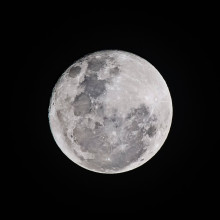
55:52 - QotW: Does relativity make moon rocks older?
QotW: Does relativity make moon rocks older?
James Tytko spoke to Proffessor Ruth Gregory from King's College London who helped makes sense of relativity in a relatively straightforward way...
Ruth - What you are probably referring to, Ranjit, is the fact that gravitational fields affect the local passage of time, with time slowing down in a strong gravitational field, such as near a black hole.
James - For this theory, we have Albert Einstein to thank, who abolished the Newtonian idea that we inhabit a 3 dimensional universe in which time passes uniformly throughout.
Ruth - The effect we are discussing is known as gravitational redshift, an amazing example of how taking simple physical knowledge can lead to a deep result. We all know it takes work to climb a flight of stairs, and that is no different for a quantum of light, called a photon.
James - Light comes in little packets, photons. If a photon loses energy (such as when it experiences stronger gravity), it increases its wavelength, and since the red end of the spectrum of visual light is the longest, we call this phenomenon redshifting.
Ruth - What was remarkable about Einstein’s intuition is that he realised this frequency of light was like the ticking of a clock. Think of a wave, from crest to crest is the wavelength, and the frequency is the number of crests passing per second. Each crest is like the tick of a clock, and a second for an observer deeper in a gravitational well would be longer than a second for someone outside this gravitational potential.
James - This effect has been verified experimentally, but the effect is tiny for objects in our solar system, such as the Earth and Moon.
Ruth - It requires the supreme precision of atomic clocks to see. For example, the difference in a clock at the Earth’s surface and one at the Moon is roughly a second in a human lifetime. Even over 5 billion years the difference is just a handful of years. So, to answer your question, no, it is not going to be a detectable effect for astronauts collecting rocks from the Moon for quite some time! Great question though!
James - So Ranjit, as I understand it, Gravitational time dilation can equivalently be interpreted as gravitational redshift, during which, photons losing energy in higher gravitational potential experience an increase in their wavelength, and thus a slowing down of the passage of time. The effect is so tiny in the context of the earth and the moon that, sadly, you would not expect astronauts to ever be bringing back moon rocks which look visibly any older than they would be if they had been residing here.
Related Content
- Previous Genocide
- Next Solving puzzles to help cancer research










Comments
Add a comment